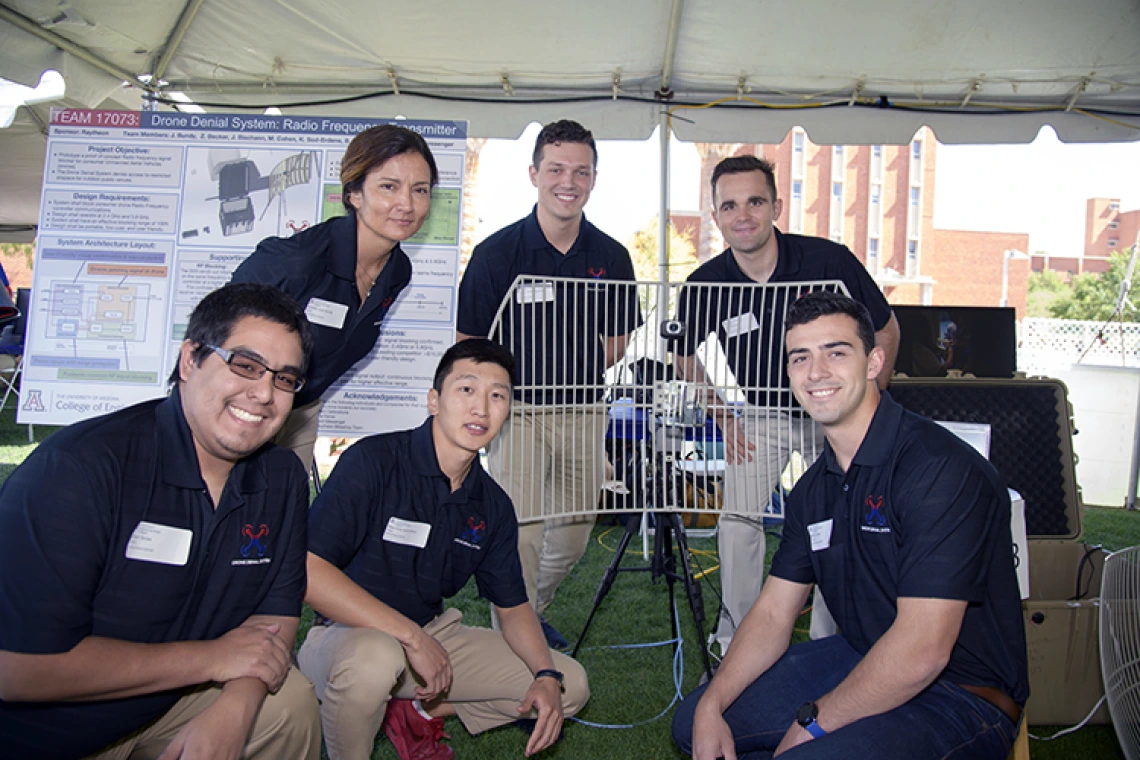A Cost-Effective System to Keep Skies Drone-Free


Project Title: Active Drone Denial
Team 17073 Members:
Zachary Wolfgang Becker, mechanical engineering
Jered Bischann, mechanical engineering
Jennifer Lynn Bundy, systems engineering
Mitch Cohen, mechanical engineering
Khas Ochir Sod Erdene, electrical and computer engineering
Bryan Serpa, electrical and computer engineering
Sponsor: Raytheon
Drones Descending, Patent Pending
To keep drones out of the skies over certain areas, including sports arenas, concert venues and schools, some companies have developed technologies to create restricted air spaces.
One method for doing so is called radio frequency jamming, or RF jamming, i.e., sending out radio signals on the drone’s frequency and thereby disabling the connection with its remote control. This forces the drone to either drop from the sky or automatically return to its controller, depending on the drone model.
However, these systems can be expensive. In his research, University of Arizona mechanical engineering major Jered Bischann found that developing RF jammer projects can run companies anywhere between $2 million and $20 million.
Stepping Outside Comfort Zones to Create Drone Dead Zones
For their senior capstone project, Team 17073 developed an RF jamming solution for sponsor Raytheon that is simpler, cheaper and more cost-effective than other technologies on the market. To do it, they each had to take a step outside their comfort zones.
For example, RF jamming is a specialized field within electrical engineering that no one on the team was familiar with. Zachary Becker, a mechanical engineering major, stepped up to become the team’s RF jamming expert — an effort that earned him second prize for the II-VI Optical Systems Fish Out of Water Award at Engineering Design Day 2018.
Mitch Cohen, also a mechanical engineer, used his experience at a past internship to take charge of the project’s 3D printing and modeling.
“We were just a team that found our own roles that we were not only best at, but that we also enjoyed,” said Bischann, who took on management and communications responsibilities for the group.
A key element that made the project unique was the subsystem the team selected for their transmissions: a plain old Wi-Fi router, costing about $250. Many companies use special frequency generators, worth thousands of dollars, to fine-tune the frequencies their systems target. In their research, however, Team 17073 found that most commercially available drones operate on frequencies of 2.4 and 5.8 gigahertz — the same frequency Wi-Fi routers use.
Patent Pending With Help From TLA
As the project wrapped up, the team’s mentor, Bob Messenger, recommended they seek the intellectual property rights for their device, with the aim of forming a startup, selling the IP to another company, or simply gaining the experience of pursuing a patent.
The team confirmed that Raytheon didn’t want to claim the intellectual property and began working with the UA office that helps researchers commercialize their inventions, Tech Launch Arizona.
Bischann and his teammates continued to explore the business of engineering. For example, they learned that under U.S. law, a patent must be statutory — a type of invention that’s able to be patented — as well as new, useful and non-obvious.
They focused on the non-obvious aspect of their device by emphasizing their use of a Wi-Fi router. While the patent is still pending, Bischann said the entire process, from learning how to manage a budget to forming connections across industries, has been invaluable.
“The experience definitely helped me get a career job,” said Bischann, who moved to San Diego to work with Naval Air Command after graduation. “I was able to see the connection with the business side of engineering.”

